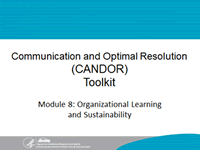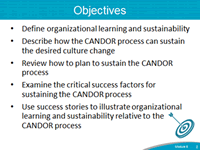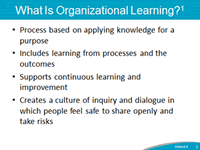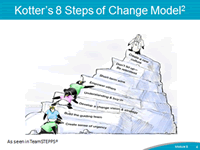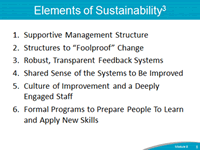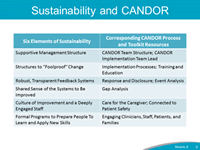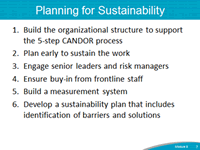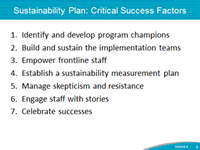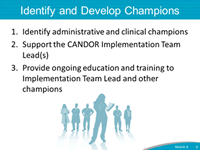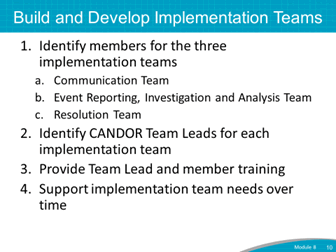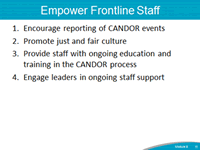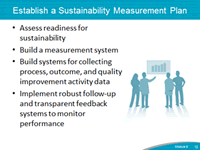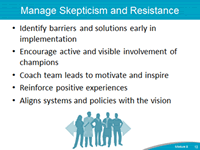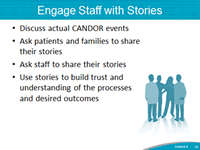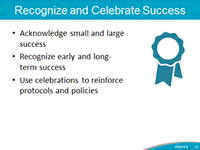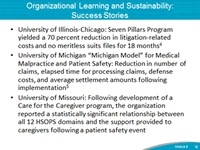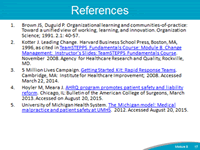Module 8: Organizational Learning and Sustainability
AHRQ Communication and Optimal Resolution Toolkit
Facilitator Notes
| Say:
Module 8, the last module in the CANDOR Toolkit, provides an overview of organizational learning and how an organization can develop a sustainability plan to assure the CANDOR process continues beyond initial implementation. |
Slide 1
|
| Say:
At the end of this module, the learner will be able to:
|
Slide 2
|
| Say:
Organizational learning is a process that involves applying knowledge for a purpose and learning from the process and the outcome. The goal is for the organization to continually improve and learn. The process of organizational learning also links individual and organizational performance and creates a culture of inquiry and dialogue in which people feel safe to share openly and to take risks. The characteristics of a learning organization are supported through the implementation of the CANDOR process. After the resolution of a CANDOR event, information is fed into an organization’s performance improvement metrics, which allows for improvement of CANDOR processes, and prevention of similar harm events in the future. The Implementation Team Lead and other Team Leads help build and promote a shared vision of organizational learning that can challenge the way "we’ve always done it." CANDOR process leaders are able to support continuous learning from the CANDOR process and from the outcomes of CANDOR events. |
Slide 3
|
| Say:
Sustainability occurs after an organization has made significant changes to improve performance. Many models in the literature define the steps of change that lead to a sustainable improvement. The different models explain the process of change and how individuals deal with change. One of the more recognized models is John Kotter’s 8-Step Process for Leading Change. In this model, Kotter defines 8 steps to creating change, with Steps 7 and 8 focusing on sustainability. Kotter’s Step 7 is "Don’t let up—be relentless." This step involves using the knowledge and the momentum from short-term wins to align an organization’s systems and policies with the new vision and to train a workforce to fulfill the vision. This stage also developing strategies to maneuver around obstacles and barriers that may threaten the change effort. Kotter’s Step 8 is "Create a new culture." This step involves making the desired changes routine and apart from daily life in the facility. During this stage, leaders assure transparency in data surrounding the change effort to support continuous evaluation and modification of the change. Both Steps 7 and 8 involve continuous organizational learning and are consistent with Phase 3, the “making it stick” phase, of the CANDOR process. |
Slide 4
|
| Say:
Sustainability occurs when processes, outcomes, ideas, beliefs, principles, or values underlying an initiative continue beyond the implementation phase of a project. Sustainability can also be described as “when new ways of working and improved outcomes become the norm.” A process which has been integrated into the organizational culture is more likely to continue to produce a specific quality improvement or long-term outcome. The Institute for Healthcare Improvement identified six common elements of sustainability. These elements include:
|
Slide 5
|
| Say:
The six elements of sustainability can be found in the CANDOR process and toolkit resources. Supportive management structure—The CANDOR process components that represent a supportive management structure constitute the CANDOR Team Structure. Structures to “foolproof” change—These are system design elements that ensure all elements of the CANDOR process are being followed. These may include a checklist to follow after an event. Robust, transparent feedback systems—The CANDOR process components that correspond with transparent feedback systems are Response and Disclosure and Event Analysis. Shared sense of the systems to be improved—The entire CANDOR process fosters a culture of improvement around the response to unexpected patient harm events. This desire to improve should be shared among the organization as well as the patient and family. Culture of improvement and a deeply engaged staff—The Care for the Caregiver program and the engagement of staff, patients, and family members represent significant efforts to promote deep engagement on the part of all stakeholders. Formal programs to prepare people to learn and apply new skills—The CANDOR process educational resources are designed to build capacity among clinicians, staff, patients, and family members and to equip staff to lead effective program implementation. The overall CANDOR process facilitates an environment of trust, which supports sustainment of program goals. |
Slide 6
|
| Say:
Sustainability of the CANDOR process must start with an organization’s commitment to make the necessary changes that promote a timely, thorough, and just response to unexpected patient harm events. To ensure sustainability, it must be planned. This planning must start early in the process using the right organizational structure to support implementation. It must include engagement of key stakeholders, such as senior leaders, risk managers, staff, patients, and families. The organization needs a measurement system to track and record process improvement over time and must identify when the process requires review and revisions. Ultimately, the organization should develop a formal sustainability plan that can identify barriers or resistance to change, and solutions to sustain the processes and continue to improve outcomes. |
Slide 7
|
| Say:
The CANDOR process is designed to help ensure sustainability through implementation and continuous learning using the educational materials and tools. However, there are several critical success factors for sustaining the processes and realizing the desired performance improvement. Note that while the first three steps are part of the initial implementation of the CANDOR process, these steps form an important foundation that supports and sustains the program beyond implementation. The critical success factors include:
|
Slide 8
|
| Say:
The first step in the sustainability process is to identify and develop the administrative and clinical champions who will communicate and reinforce the CANDOR process goals. The CANDOR Implementation Team Lead is an essential champion who is identified early in the implementation of the CANDOR process. The CANDOR Implementation Team Lead not only explains the program goals and components, but also helps identify, engage, and inspire other champions. The identification of champions is part of the assessment phase, but developing champions must continue following implementation to truly sustain the culture change. The organization can support the CANDOR Implementation Team Lead and other champions by providing ongoing educational opportunities, so the champions can continue to advocate for the CANDOR process and help sustain improvement over time. |
Slide 9
|
| Say:
After identifying and developing the champions, the organization is responsible for building the implementation teams. The implementation teams help drive the project and are responsible for implementing the individual steps of the CANDOR process. The three CANDOR implementation teams include:
Again, while this step is part of the initial implementation of the CANDOR process, it supports and sustains the program beyond implementation. It is important that the organization continue to provide Team Lead training and support following implementation to sustain the CANDOR process. Over time, the needs of each of the implementation teams may diminish or increase, depending on the learning needs of the organization and the opportunities for improvement identified throughout the sustainment period. Modules 4, 5, 6, and 7 provide additional details about the responsibilities of each of the implementation teams. |
Slide 10
|
| Say:
Frontline staff are the key to the ground level implementation of the CANDOR process. Over time, the organization must continue to encourage frontline staff to report CANDOR events and other adverse patient events by promoting transparency and a fair and just culture. By providing frontline staff with ongoing education and training in the CANDOR process, the organization can continue to learn from errors and prevent similar harm events in the future. The CANDOR Implementation Team Lead and Team Leads play an important role in ensuring that frontline staff remain engaged and empowered, even after initial implementation of the program. Leaders can empower frontline staff through:
Celebrating staff for reporting CANDOR (and other) events, such as near misses and unsafe conditions. |
Slide 11
|
| Say:
Establishing a sustainability measurement plan is a key step in determining whether the improvement is actually being sustained. CANDOR team leaders can continue to build systems for collecting process, outcome, and QI activity data for the program after the initial implementation. By using those data to continuously improve performance, the organization is better equipped to sustain improvements and continuously improve outcomes. Establishing a sustainability measurement plan starts with an assessment of readiness to sustain the culture change realized through the implementation of the CANDOR process. The next step is to build a measurement system that includes what data will be collected over time, who will collect the data, when the data will be analyzed and shared, and how the data will be used to promote continuous learning and improvement. The measurement system should include information on process, outcome, and quality improvement activities and support robust followup and transparent feedback systems that continuously monitor performance metrics. |
Slide 12
|
| Say:
The knowledge gained through the implementation of the CANDOR process can help the organization develop strategies to maneuver around obstacles, such as skepticism and resistance, that may threaten the change effort over time. It is important to identify and address barriers during and after the initial implementation process so that solutions can be found and before resistance negatively impacts the continuation of key processes. Active and visible involvement of the CANDOR champions can also energize leaders and staff and continue to promote desired behaviors. Team leads should continue to be coached to motivate leaders and team members to support program interventions, highlight positive outcomes from new processes, and dedicate time and resources to implement the interventions. Leaders can also reinforce positive staff experiences from new processes to help overcome resistance over time. Organizations can sustain the program by using the knowledge and momentum from CANDOR process analyses ("wins") to align systems and processes with the vision, thereby demonstrating to staff how the CANDOR process supports them in the work they do. Module 2 includes additional information on obtaining organizational buy-in and support from leaders and staff. |
Slide 13
|
| Say:
Stories are a powerful way to engage staff, patients, and families in ways that data collection and measurement activities cannot. Encourage your Team Leads to discuss actual CANDOR events to drive home important lessons. Ask patients and family members to share their stories to put a human face on a harm event and engage staff to support the process. Ask staff to share their stories of patient harm. By engaging staff in stories and demonstrating concern for staff experiences, organizations can build trust and relationships that support sustainability efforts and promote success.
|
Slide 14
|
| Say:
Recognizing and celebrating success is important to sustaining change and continuous improvement in the CANDOR process. Large and small successes should be recognized. Teams should celebrate successes both early in the implementation process and after the initial implementation. Recognizing success will help frontline staff speak up and share challenges and will reinforce to the entire team the importance of program interventions. Celebrations need not be elaborate or formal to help sustain progress and continue to improve outcomes. Simple recognitions can improve buy-in from clinicians and staff, and can motivate teams to follow protocols and policies. In summary, sustainability can help organizations embed processes into their organizational culture, making improvement the norm. Organizations need to address external and internal factors that can benefit or impede sustainability. An effective sustainability plan involves planning early in the improvement process, choosing easy-to-reach goals that are attainable, identifying a strong program champion to rally around the improvement, choosing a focus that fits with the organizational mission, and ongoing evaluation and transparency of process and outcome measures. |
Slide 15
|
| Say:
Here are some examples of success from organizations that are implementing CANDOR process principles:
|
Slide 16
|
|
Slide 17
|




